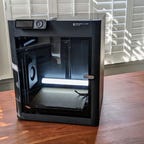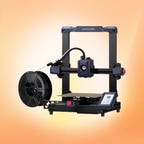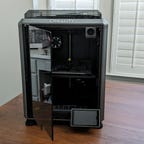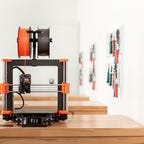Best Fast 3D Printers of 2024
Ultrafast 3D printers are here, and we've been testing them to see if they're worth the hype. (Spoiler alert: They are)
Our Picks
Achieving good quality 3D prints always came at the cost of speed, which used to be OK, because a 14-hour print was better than the days it would take and the sums of money it would cost to get something made in a factory. We've been testing 3D printers for nearly a decade now, and they've always been a little slow.
With the advent of fast 3D printers though, we can cut that 14-hour print time to seven hours or less. This saves time and money and lets your creative juices flow much faster. If you already own any of the current best 3D printers, you may not want to upgrade to a faster printer just yet and that's OK. But, if you're on the lookout for a printer that offers excellent quality and can blow you away with its speed, we have the goods right here.
What's the best fast 3D printer?
Balancing that sweet spot between affordability and usability, the P1S from BambuLab is currently the best fast 3D printer to buy. It isn't the pinnacle of fast printers on the market -- that would be its big brother, the X1C -- but it is significantly cheaper, making it a better value proposition than the X1C.
Fast 3D printers are still relatively new, so this list will be updated on a regular basis from here on out. Keep your eye out for new printers to be added as we finish testing each one.
Best fast 3D printers
The P1S is an updated version of our previous best 3D printer winner, the P1P. Each of the updates to the machine -- plastic side panels, glass top and door, camera, part fan and LED light -- help raise the P1S to be our No. 1 pick.
The quality of the models and the speed at which it can print them is amazing and very few printers can do both of those things at anywhere near the same price. The P1S beats out its predecessor, even though it is the same machine in every mechanical way, because the case and door make it a more well-rounded product.
- Material type: Filament
- Build area (mm): 256 × 256 x 256
- Official max printing speed (mm/s): 500
- Dimensions (mm): 389 x 389 x 458
- Price: $$$
Best budget fast 3D printer
Anycubic Kobra 2
While not as fast as the P1P or the X1C, the Kobra 2 is around the same speed as the AnkerMake M5. It will happily produce prints at 250 millimeters per second, though the best quality seems to be hovering around 150mm/s in my testing. It also comes with a filament runout sensor and bed leveling, which works extremely well.
The big selling point for the Kobra 2, though, is the price. It has all the advantages of a faster printer but with a sub-$300 price tag, which is astonishing. This is my recommendation for any first-time buyer or someone on a budget.
- Material type: Filament
- Build area (mm): 250 x 220 x 220
- Official max printing speed (mm/s): 300
- Dimensions (mm): 486 x 440 x 435
- Price: $
Fast 3D printing at a budget price
Creality K1 Max
The K1 Max is the largest of the fast 3D printers I've tested so far with a 300mm cubed area. It's large enough to print a helmet big enough to fit my massive head with room to spare and it will do it at a confirmed speed of 300mm/s.
Like its smaller sibling, the K1, the K1 Max is well built for a Creality machine and is simple to get excellent prints with. Setup was easy and despite the filament loading being a bit of a pain, the printing runs smoothly. If you're looking for a good cosplay printer, this is the one for you.
Read more: Creality K1 Is Its Answer to Bambu and Prusa
- Material type: Filament
- Build area (mm): 300 x 300 x 300
- Official max printing speed (mm/s): 600
- Dimensions (mm): 355 x 355 x 480 (K1 Max)
- Price: $$$
Best color-ready fast 3D printer
Bambu Lab A1 Mini Combo
The A1 Mini Combo is an almost perfect entry to the world of color 3D printing. It's well priced, and while the build area is small, the quality of the print -- and the fact you can print in four colors straight out of the box -- is amazing. If you're looking for your first printer and want to try color printing, this is a no-brainer.
- Material type: Filament
- Build area (mm): 180 × 180 x 180
- Official max printing speed (mm/s): 500
- Dimensions (mm): 347 × 315 × 365
- Price: $$
Fast 3D printing with quality at the forefront
Prusa MK4
Right now, the Prusa MK4 is sitting on my workbench, churning out excellent prints by the bucketful. I'm still not quite finished with the full review, but so far, the MK4 is living up to Prusa's excellent reputation. Almost every aspect of the MK4 is an upgrade to the MK3S Plus, with a new removable nozzle setup, a new extruder, and an automatic z-height adjustment system that promises "perfect first layers every time."
Testing isn't quite finished yet, but Prusa has a great track record, so this isn't likely to be a bad machine; it's likely to be a great one.
Read more: Prusa MK4 Follows Up Best in the Business
- Material type: Filament
- Build area (mm): 220 × 210 × 250
- Official max printing speed (mm/s): 500
- Dimensions (mm): 500 × 550 × 400
- Price: $$$$
Well built fast 3D printer
AnkerMake M5
One of the first consumer 3D printers to break the 250 millimeter-per-second speed barrier, the AnkerMake M5 has recently had a software update to push its speed up to 500mm/s on its ultrafast mode. The M5 uses an AI camera to help you detect issues so you can stop a failing print before you waste a lot of material. The AI is particularly bad, but the camera does give you some fantastic time-lapse videos to share on social media.
Read more: AnkerMake M5 Review
- Material type: Filament
- Build area (mm): 235 × 235 × 250
- Official max printing speed (mm/s): 500 (fast mode), 250 (standard)
- Dimensions (mm): 502 × 438 × 470
- Price: $$$
Fast 3D printing for the niche crowd
Bambu Lab X1 Carbon
Of all the fast 3D printers I've tested, the X1 Carbon reigns supreme. In every category I test, it stands out on top. The only thing that keeps it from being my top pick is the cost. This enterprise bundle, while offering a lot of value, is still $1,844, nearly three times the price of the AnkerMake M5.
The X1C is custom-made for exotic materials that require a hardened nozzle. Things like carbon fiber-infused materials require a stronger nozzle, or they will be worn down very quickly. When you couple that with the lidar bed leveling, AMS color system and an AI camera to spot errors, you have a formidable machine.
Read more: Bambu Lab X1 Carbon vs. Bambu Lab P1P
- Material type: Filament
- Build area (mm): 256 × 256 x 256
- Official max printing speed (mm/s): 500
- Dimensions (mm): 389 × 389 × 457
- Price: $$$$
Other fast 3D printers we've tested
While these printers are in the same ultrafast vein as the others, we have yet to completely test them in the way we would want. Because of that, we are not able to recommend them fully, at least until our full testing is complete.
Fast 3D printing for the beginner
Elegoo Neptune 4 Pro
Like the Kobra 2, the Elegoo 4 series is an entry-level, budget-friendly set of machines that make it easy to start printing good-quality prints at a super friendly price. The Neptune 4 Pro is the top end of these entry-level printers and has some advanced features for its price, including full auto bed leveling, a filament run-out sensor and even a full-width part fan to help cool at high speed.
Whether you choose the Neptune 4 Pro, Neptune 4 or Neptune 4 Plus, you'll get an excellent printer at a bargain basement price.
- Material type: Filament
- Build area (mm): 225 × 225 x 265
- Official max printing speed (mm/s): 500
- Dimensions (mm): 389 × 389 × 457
- Price: $
How we test 3D printers
Testing 3D printers is an in-depth process. Printers often don't use the same materials, or even the same process to create models. I test SLA, 3D printers that use resin and light to print, and FDM, printers that melt plastic onto a plate. Each has a unique methodology. Core qualifiers I look at include:
- Hardware quality.
- Ease of setup.
- Bundled software.
- Appearance and accuracy of prints.
- Repairability.
- Company and community support.
A key test print, representing the (now old) CNET logo, is used to assess how a printer bridges gaps, creates accurate shapes and deals with overhangs. It even has little towers to help measure how well the 3D printer deals with temperature ranges.
When testing speed we slice the model using the standard slicer the machine is shipped with on its standard settings then compare the real-world duration of the print to the statement completion time on the slicer. 3D printers often use different slicers, and those slicers can vary wildly on what they believe the completion time to be.
We then use PrusaSlicer to determine how much material the print should use and divide that number by the real-world time it took to print to give us a more accurate number for the speed in millimeters per second (mm/s) the printer can run at.
Every build plate is supposed to heat up to a certain temperature so we use the InfiRay thermal imaging camera for Android to check how well they do. We set the build plate to 60 degrees Celsius -- the most used temperature for build plates -- waited 5 minutes for the temperature to stabilize, then measured it in six separate locations. We then took the average temperature to see how close the 3D printer got to the advertised temperature.
Testing resin requires different criteria so I use the AmeraLabs standard test -- printing out a small resin model that looks like a tiny town. This helps determine how accurate the printer is, how it deals with small parts and how well the UV exposure works at different points in the model.
Many other anecdotal test prints, using different 3D models, are also run on each printer to test the longevity of the parts and how well the machine copes with various shapes.
For the other criteria, I research the company to see how well it responds to support queries from customers and how easy it is to order replacement parts and install them yourself. Kits (printers that come only semiassembled) are judged by how long and difficult the assembly process is and how clear the instructions are.






